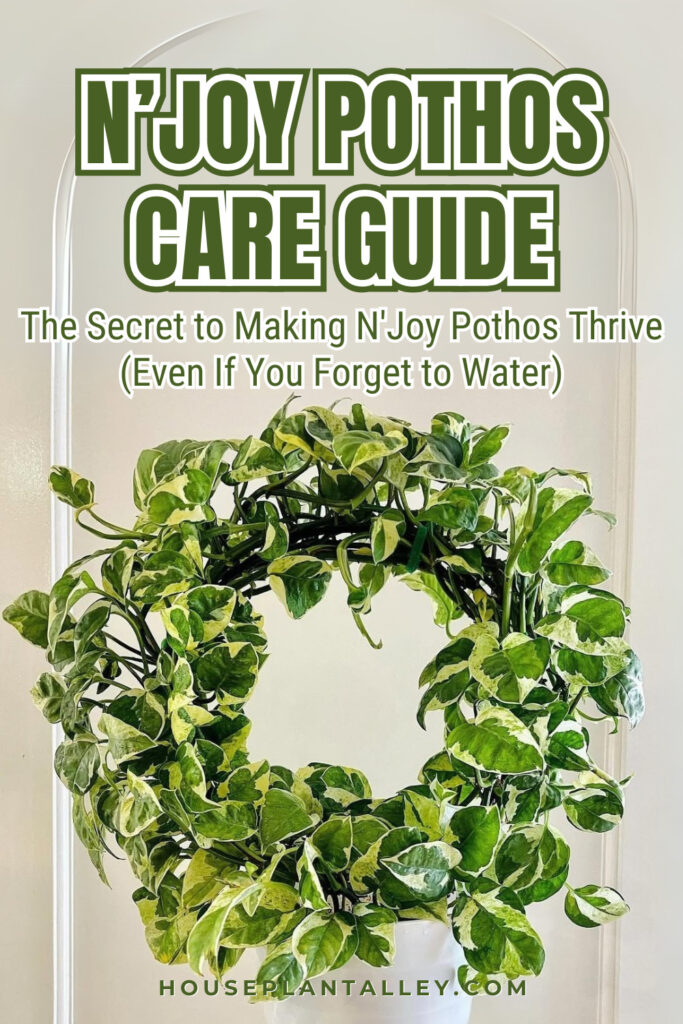Pothos N’Joy is a beautiful houseplant with creamy white and green leaves. You might’ve seen it in plant shops—it’s small but eye-catching. But don’t let its size fool you! This plant needs a bit more care than regular golden pothos, especially when it comes to light and water. If you don’t get it right, the white parts can turn brown or disappear completely. Let’s break down how to keep your Pothos N’Joy happy and healthy.

🛍️ What Is Pothos N’Joy and Where to Buy It
Pothos N’Joy became popular because of its pretty variegated leaves and compact size. It was discovered in 2002 and officially patented in 2007. It’s a type of Epipremnum aureum, which originally comes from the tropical rainforests of French Polynesia.
To buy one:
- Check your local plant nurseries first.
- Try online plant shops or Etsy—but make sure the seller has good reviews.
- Once you bring it home, let it rest for a few days before repotting or changing its care routine.
🪴 How to Pot and Repot Your Pothos N’Joy
When it’s time to repot:
- Use pots that drain well, like terra cotta or fabric ones.
- Hanging baskets work great if you want the vines to trail down.
- Be gentle when moving the plant. Loosen the roots and use fresh soil.
- Water it well after repotting.
Only repot every 2–3 years, or when roots start growing out of the bottom. Pick a pot that’s just one size bigger to avoid soggy soil and root rot.
☀️ Light, Water, and Daily Care

Pothos N’Joy is pretty easy to care for once it’s settled in:
- Place it near east or west-facing windows. Avoid strong sunlight—it can burn the leaves.
- Water when the top 2 inches of soil feel dry (usually every 1–2 weeks).
- Keep humidity above 50%. Mist the leaves, use a humidifier, or place it in a bathroom for extra moisture.
- Keep the temperature between 70–75°F and avoid cold drafts.
🧼 Maintenance and Common Problems
To keep your plant looking great:
- Wipe the leaves with a damp cloth every few months to remove dust.
- Clear away dead leaves or debris to prevent pests.
Absolutely! Here’s the table with proper alignment for easy reading:
🛠️ Common Pothos N’Joy Problems and What They Mean
|
Symptom |
Possible Cause |
|---|---|
|
Yellow leaves |
Too much water, not enough light, or lack of nutrients |
|
Wilting |
Underwatering or pest damage |
|
Brown spots |
Dry air, underwatering, or too much direct sunlight |
Trim damaged stems just above a leaf node using clean scissors. Check monthly for pests like spider mites or mealybugs.
🌱 Propagation and Fertilizer Tips
Want more Pothos N’Joy plants? Try these two methods:
- Stem cuttings: Cut below a leaf node and place in water or soil.
- Shoot division: Separate new shoots from the main plant and replant.
Feed your plant during spring and summer:
- Use liquid fertilizer every 2–4 weeks, but dilute it to half strength.
- Or use slow-release pellets in the soil.
- Fresh soil during repotting also gives your plant a nutrient boost.
🌟 Expert Tips for Thriving Growth
To help your Pothos N’Joy grow strong:
- Give it bright, indirect light. Too little light makes the white parts fade, and too much sun burns the leaves.
- Keep humidity above 50% to avoid crispy edges.
- Water when the top of the soil dries out.
- Wipe leaves monthly and check for pests.
With the right care, your Pothos N’Joy will stay vibrant and beautiful!
